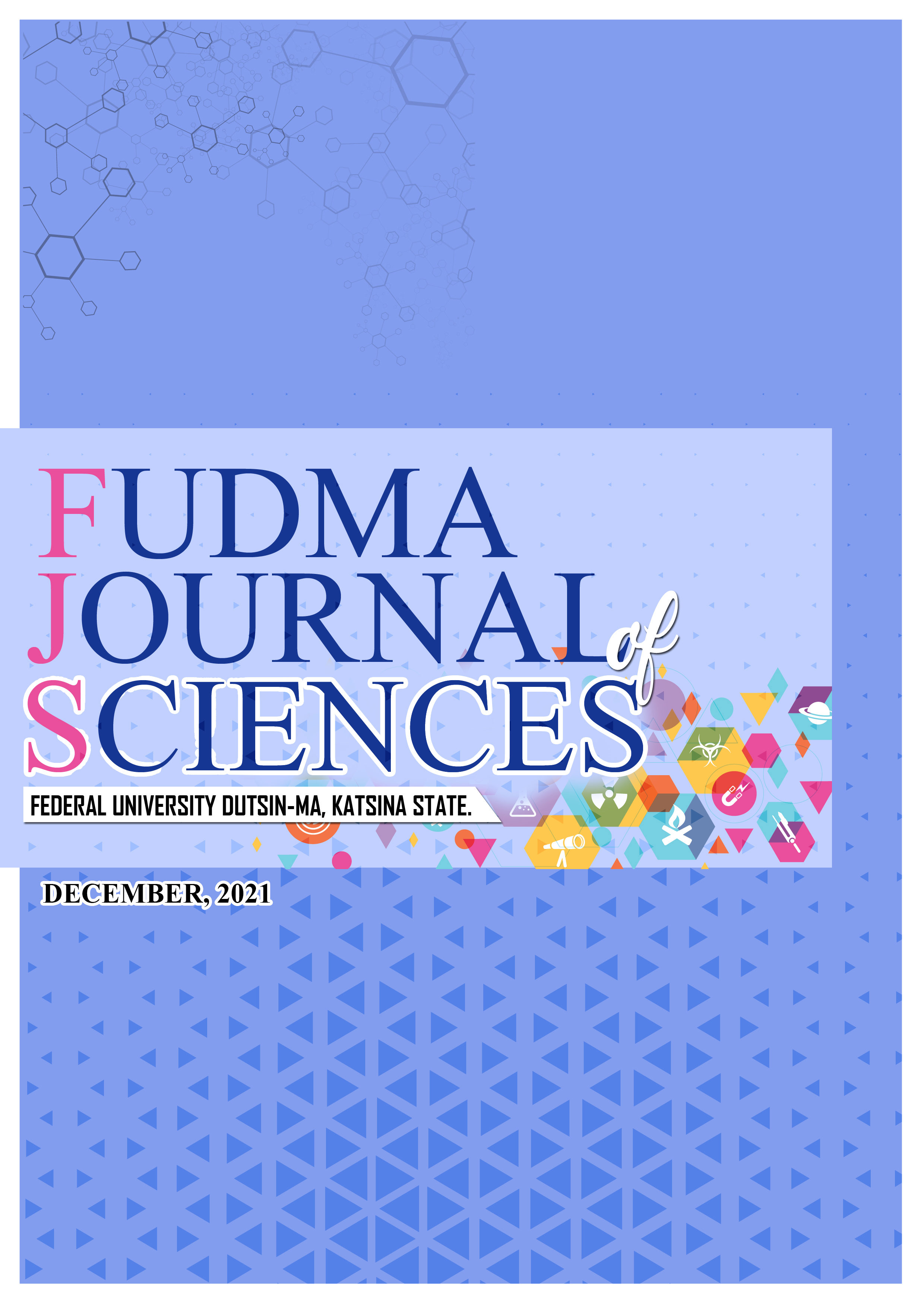SYNTHESIS, CHARACTERIZATION AND ANTIMICROBIAL ACTIVITIES OF Ni(II) AND Cu(II) COMPLEXES WITH SCHIFF BASE DERIVED FROM 2-ACETYL-5-METHYLFURAN GLYOXIME HYDRAZONE
DOI:
https://doi.org/10.33003/fjs-2021-0504-813Keywords:
Ni(II) and Cu(II) complexes with hydrazone Schiff BaseAbstract
A hydrazone Schiff base has been synthesized by the interaction of ethanolic solution of antiglyoxime hydrazine with 2-acetyl-5-methylfuran, to obtain the corresponding Schiff base L. The complexes of Ni(II) and Cu(II) of the Schiff base were synthesized and studied. The Schiff base and its metal(II) complexes characterized based on solubility, percentage yield, elemental analysis, melting/decomposition temperatures, infra- red spectral (FT-IR), conductivity measurement, magnetic susceptibility and water of crystallisation. The synthesized Schiff base and the complexes are coloured and stable at room temperature. Based on the results the prepared Schiff base and synthesized complexes are relatively soluble in most organic solvents but insoluble in distilled water. The melting point temperature of the ligand was 118oC while the decomposition temperature for metal complexes were 308 and 300oC respectively. The molar magnetic susceptibility of the complexes were 3.55 and 2.10 x 10-3 erg.G-2mol-1. The molar conductance values of 2.17 and 2.43ohm-1cm2mol-1 indicating non electrolytic nature of the complexes. The spectral data of the Schiff base showed band of 1584cm-1, revealing the formation of the azomethine. A bands of 791cm-1 indicate the metal nitrogen bond. The elemental analysis determination of the complexes and the Schiff base showed the metal ligand ratio of 1:2 (M:2L). The antibacterial and antifungal activities of the Schiff base and the metal(II) complexes were evaluated using disc diffusion method. The antibacterial assay was carried out on three pathogenic bacteria, Staphylococcus aureus, Staphylococcus epidermidis and Streptococcus pneumonia and two fungi viz: Candida utilis and Saccharomyces cerevisiae. All the Schiff base
References
Abdul, R.,(2008). “Synthesis, characterization and Antimicrobial Activity of Long- Chain Hydrazonesâ€. Acta Chimica Slovenica 55.2 : 448-452.
Adeola, A. N., Gabriel, A. K, and Ayorinde, O. N., (2010). Synthesis, Characterisation, Antibacterial and Thermal Studies of Unsymmetrical Schiff base Complexes of Cobalt (II). Journal of Coordination Chemistry, 64(24): 4398-4410.
Aliyu, H. N. and Sani, U. (2012). Synthesis, Characterization and Biological Activity of Manganese(II), Iron(II), Cobalt(II), Nickel(II) and Copper(II) Schiff Base Complexes against multidrug Resistant Bacterial and Fungal Pathogens. International Research Journal of Pharmacy and Pharmacology (IISSN 2251-0176). Vol..2:(2) pp 040-044.
Anu, M., Laksmi, Prabha, G. Banukarthi, P. Rexy Kanjana, K. Rajeswari (2013). Uv- visiblele, IR and NMR spectra on copper(II) Schiff Base complex. International Journal of Institutional pharmacy and life sciences 3(6).
Ashraf, M.A., Mahmoud, K.A., Maah, M.J., and Yusoff, I. (2011). International conference on chemistry and chemical process IPCBEE. Singapore, 10: 1-7.
Eman, T. S. (2015). Synthesis, Characterization and Spectroscopic Studies of 2-{{E}-hydroxyphenyl imino) methyl} phenol Schiff base with some metal Complexes. Journal of Al-Nahrain University, Vol.18(1)Pp. 39-45.
Ibrahim M. N., Sharif S.E.A., (2007), synthesis, characterization and use of Schiff Bases as fluorimetric analytical reagents. E-J. Chem., Vol. 4, pp.531–535.
John, D. (2008). A Dictionary of Chemistry,sixth edition, Oxford University Press, UK, PP274.
Lancanshire, R. J., (2000). Determination of Magnetic Susceptibility of Transition metal Complexes. http://www.chem.uw.imona.edu.jm/labmanuals/DiamCorr.html (modified on 22nd October, 2002).
Moamens, R. and Ibrahim M., (2013). Spectroscopic, Structural and Electrical Conductivity studies of Cu(II), Ni(II) and Co(II) Complexes Derived from 4-acetylpyridine with semicarbazide. International Journal of Electrochemical Science. 1(8):9898-9917.
Mohammed, M. E. Shakdofa, Fathy A. El-Saied, Anas J. Rasras and Ahmed N. Al-Hakimi (2018). The transition metal complexes of a hydrazone-oxime ligand containing the isonicotinoyl moiety: Synthesis, characterization and microbicide activities. Journal of Applied Organometallic Chemistry, Wiley publshers.
Naeimi H., SafariJ., Heidarnezhad A. (2007, Synthesis of Schiff base ligands derived from condensation of salicylaldehyde derivatives and synthetic diamine. Dyes and Pigments, Vol. 73, pp.251–253.
Olalekan, T. E. and Bankare T. E. (2015). Synthesis of 2-aminobenzoic acid metal (II) complexes by Schiff base hydrolysis and microbial potency studies. Pacific journal of science and technology, 16(1):233-239.
Parveez, G., Shaeel Ahmed Al-Thabaiti and Athar Adil Hashmi (2014) International Journal of Multidisciplinary and Current Research P1142-1147.
Saeed, Jamebozorgi and Mozhdeh Liyaghati-Delshad. (2015) journal of novel Applied Sciences. 4-2/p135-139.
Sridhar, S.K., (2002) anticonvulsant activity of hydrazones, Schiff base “European Journal of Pharmaceutical Sciences. 16.3 : 129-132.
Thilagavathi, P., Vijayanthimala R., and Bavani D., (2015). Synthesis, Characterization and Antimicrobial studies on Thorium(IV) and Cerium(IV) complexes of Vanillin Schiff bases of diamines. International journal of chemical and pharmaceutical sciences. Vol.6(6)pp 84 – 89.
Thiyagarajan, Govindasami., (2012) “Synthesis, characterization and Anti Bacterial Activity of Biologically Important Vanillin Related Hydrazone Derivativesâ€. International Journal of Organic Chemistry 1.3 : 71-77.
Vogel, A. (1978). Textbook of Practical Organic Chemistry, 4th Ed., Pp 666. London: Longman publications.





